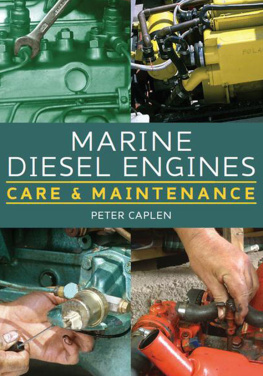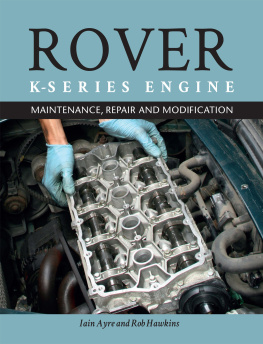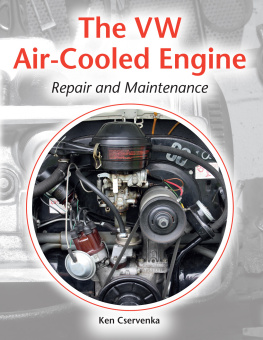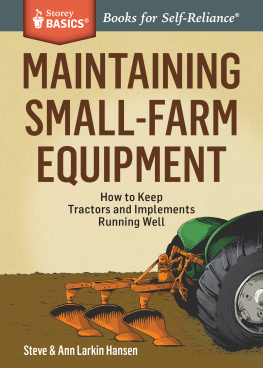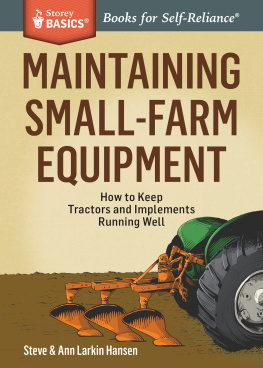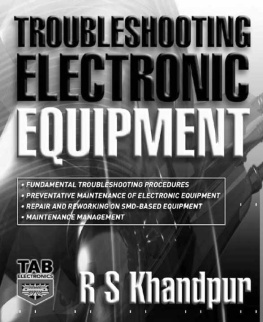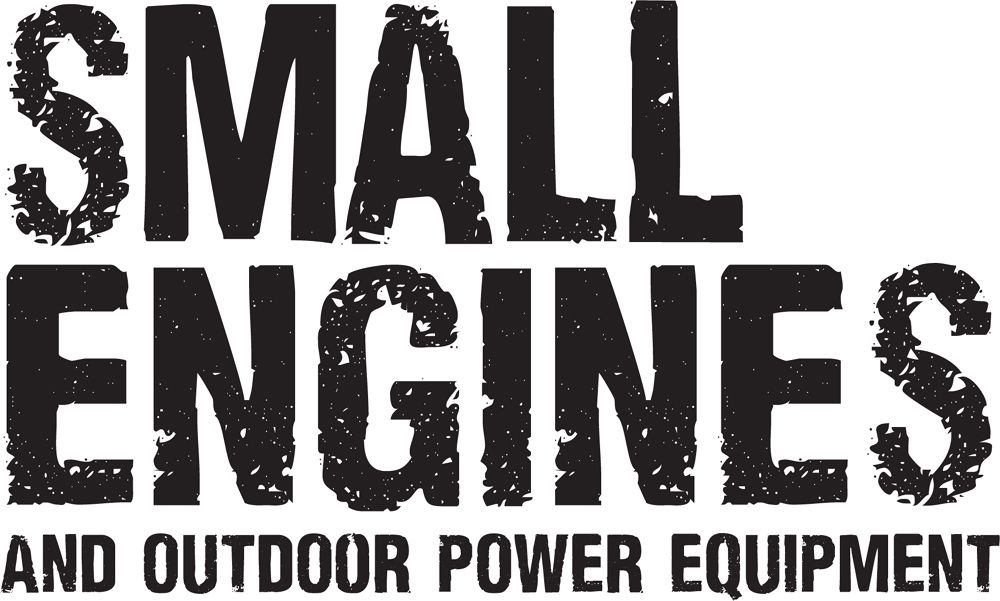A CARE & REPAIR GUIDE FOR: LAWN MOWERS, SNOWBLOWERS & SMALL GAS-POWERED IMPLEMENTS
Edited by Peter Hunn

Contents
Introduction
Unless youre among the small but enthusiastic group of motorheads who collect, troubleshoot, and restore vintage lawn mowers, chain saws, garden tractors, snowblowers, or old outboard motors as a hobby, you probably opened this book because some small engine in your life just isnt running right. Maybe its hard to start or sometimes doesnt start at all. Perhaps your small engine runs, but sounds strange; like its got real problems somewhere deep down inside.
Quite possibly youre wishing you had the mechanical equivalent of a green thumb so you could save money on small-engine repairs. With most power equipment shops charging hourly repair rates comparable to those of a luxury car dealerships service department, it is no wonder why many folks who dont consider themselves particularly handy get so darn frustrated by their persnickety weed-whacker or messed-up mower that they feel theres no alternative but to buy a new one. With all due respect to those who lack confidence in their ability to keep their little motors purring proudly season after season, Small Engines & Outdoor Power Equipment is written to prove them wrong.
NOTICE TO READERS
F or safety, use caution, care, and good judgment when following the procedures described in this book. The publisher cannot assume responsibility for any damage to property or injury to persons as a result of misuse of the information provided.
The techniques shown in this book are general techniques for various applications. In some instances, additional techniques not shown in this book may be required. Always follow manufacturers instructions included with products, since deviating from the directions may void warranties. The projects in this book vary widely as to skill levels required: some may not be appropriate for all do-it-yourselfers, and some may require professional help.
ORGANIZATION OF THE BOOK
This book walks you through lots of real world mechanical cures and problem prevention, based on the most widely used small-engine designs. You can find the step-by-step directions for your specific maintenance or fix-up project in the Table of Contents () or by delving right into one of the sections listed below. Each offers safety tips, key to efficient diagnosis, and proficient wrenching.
Things That Make A Small Engine Run () identifies parts of the small engine and outlines how they are arranged into systems: They are the compression system, fuel system, ignition system, lubrication and cooling system, braking system, and the electrical system. This chapter also identifies good tools to have on hand for repair work, as well as some pointers on safe small-engine servicing.
Motor Medical School 101 (focuses on troubleshooting that poor old motors funny noises or maybe getting it to say something nice to you again ().
Easy But Important Maintenance () offers a convenient schedule and checklist for inspecting and changing the oil, spark plugs, and filters.
Doctoring The Ailing Engine Basic Engine Repairs (), guide you through being able to and repair of the most common problems. Also covered are engine maladies, that some might consider to be a bit more challenging.
2-Stroke Power Equipment () introduces you to the basics of 2-stroke engine operation and then guides you through basic maintenance and repair common to outdoor power equipment implements such as chain saws, string trimmers, snowblowers, and gas blowers.
Things That Make a Small Engine Run
Defining the Small Engine
T he biggest difference between small gasoline engines and other types of fuel-burning motors is their small capacity and simplicity of design. Small engines generate modest amounts of powergenerally 2 to 25 horsepowercompared to a typical family car boasting 150 or more horses. And a small engines compact size also makes it easier to maintain and repair.
A typical 4-stroke, overhead valve gas engine. At 6.5 horsepower it is of average power for a lawn mower.
Because small engines are designed for relatively simple tasks like cutting grass and blowing snow, their construction is uncomplicated compared to other engines. Unlike cars and other vehicles that frequently accelerate, slow down, or idle for long periods, small engines are usually run at constant speed or change speed slightly when encountering modest changes in the load, such as when a lawn mower hits a patch of thick grass, or when a snowblower tries to digest a pile of packed snow recently shoveled off the roof and into the driveway.
Also, unlike car engines, small engines dont have to be wedged between a radiator and firewall in an automotive chassis or get linked to countless computers and other electrical devices. This makes small engine parts easier to install, adjust and remove. In many cases, you can reach even the most hidden small engine parts with just a few turns of a wrench.
ESSENTIALS OF THE 4-STROKE ENGINE
Except for most chain saws, string trimmers, leaf blowers, and light-duty snowblowers that use 2-stroke (also known as 2-cycle) engines (see 2-Stroke Power Equipment on ), the majority of small power plants are of the 4-stroke (or 4-cycle) variety. These diminutive 4-strokes follow the same essential operating principles as automotive engines. To use a bakery metaphor, the little mills on lawn mowers would be considered cupcakes compared to the far-larger, multitiered confection created for a fancy wedding reception. No matter the intended application, however, here, in its simplest form, is how a 4-stroke engine works:
When you pull the rope, known as a rewind cord, or use your electric starter, precise amounts of fuel and filtered air mix together in the carburetor. The mixture rushes into the engine to be compressed, ignited, and burned in a controlled process known as internal combustion. This produces hot gases. As these gases expand, they push a smooth, well-lubricated cylindrical component, known as the piston. The piston, in turn, drives the crankshaft, the arm that spins a blade or performs other work. Moving valves on a 4-stroke engine (and stationary ports in the cylinder wall on a 2-stroke motor) let air and fuel into the combustion chamber above the piston and allow spent gases to exit through the muffler. Pulling vigorously on that cord or turning the starter key gets this process moving. When it works correctly, it coaxes the fuel-air atomization, fuel-air compression, ignition/spark, and exhaust of burned gases to work on its own. It is designed to become self-sustaining from the time the engine starts until the moment it stops. Timed electrical surges cause the spark plug to fire repeatedly inside the combustion chamber, igniting each fresh supply of air and fuel and producing gases that continually drive the piston and crankshaft. All the while, oil from the crankcase and air circulate to keep engine temperatures within an acceptable range, and a governor monitors changes in the workload and adjusts engine speed accordingly. Theres a lot being asked of a small engine when the starter is suddenly engaged. Thats why an engine might sound like its taking a second or two to fully come to life, the way somebody might when roused out of a warm, comfortable bed when the clock radio alarm fires up on a winters morning. Two-cycle engines complete this wake-up routine in two piston strokes (one up, one down, or one 360-degree rotation of the crankshaft). For a 4-cycle engine, the whole process involves four motions of piston travel (two up strokes and two down strokes, or two full crankshaft rotations.


